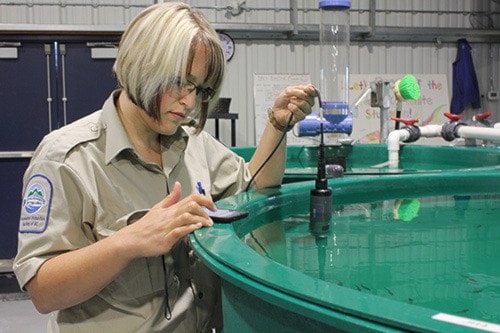Fish at the Nechako White Sturgeon Conservation Centre are growing as planned, and have survived the hardest part of the husbandry process, said senior fish culturalist Mike Manky.
"The first feeding is the most challenging stage because they are quite picky on what they'll eat and how they'll eat. We're passed that now and the fish seem to be growing really well," said Mr. Manky.
Since it's grand opening on July 17, the fish conservatory has housed approximately 12,000 baby sturgeon in hopes to putting them back into the Nechako river this spring.
With the help of 18 adult sturgeon caught in a successful brood capture, the centre had a fruitful spawning period. This was done by extracting eggs from the female's bowels and drawing sperm from the males with a rubber hose on a syringe. After the collection the eggs were mixed and fertilized and put into incubation jars that sat inside shallow ponds. Once hatched the baby sturgeon use up their yolk sac as an initial food reserve, but after that they need to be fed right away, said BJ Bruder, a junior fish culturalist whose job is to feed the fish.
"It's a critical life stage because you know what happens when you don't eat," said Ms. Bruder.
The fish food is made from various fish and comes in tiny pellets. Krill is used as a flavour enhancer to entice the fish to eat. Some fish grow faster than others so the pellets come in different sizes. Once the fish reach a certain size its important to grade them and put them into separate ponds, said Mr. Manky.
"We grade them into different ponds geared to size so the bigger ones don't eat the little ones," said Mr. Manky.
Another big reason to keep the fish separate is to avoid adult fish spreading disease into the juvenile (young) fish. To lower the chances there are three separate water filtering systems. The juvenile, adult holding and adult spawning ponds all get their own water treatment so that the water can be reused and there is a low risk of contaminating an adult disease with the baby fish.
Water sampling is also done every day to measure levels in the water for things such as ammonia and nitrate, which can be toxic to fish. Even the water temperature must be measured to maintain a proper habitat since the facility uses both water from the river and de-chlorinated city water.
"The city water comes in handy during hot weather because the river water is to warm we have to cool it down," said Mr. Manky.
Currently the baby fish are about half-an-inch to two inches and will grow to about 10 inches by the planned release date in April.
"Basically they will be the size of a sub from subway," said Ms. Bruder.
In the past, the Freshwater Fisheries Society of BC has run other pilot projects but didn't get them as big as what is planned for this batch of fish.
"Bigger fish produce a higher survival rate and since when we release them they will be quite big, we are expecting a high survival rate," said Mr. Manky.
There are two female adult sturgeon being held for next year's spawning. They are all about 65 years old and seven-and-a-half feet long. White sturgeon are the largest fresh-water fish in North America and can grow to be 20 feet in length, weigh 1,500 pounds and live over one hundred years. Free tours will continue running at the Nechako White Sturgeon Conservation Centre weekly on Thursdays from 2p.m. to 3p.m. For more information visit gofishbc.com.
